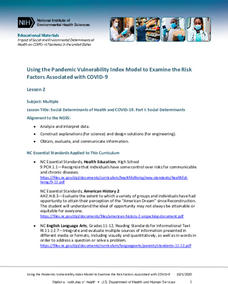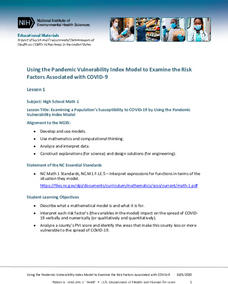Facing History and Ourselves
Mood Meter
Returning to in-class learning has proved to be a challenge for both teachers and learners. This series of 15 lessons provides instructors with ideas about establishing or re-establish classroom protocols and opening or closing routines...
PBS
Race and Vaccine Hesitancy in the US
What does race have to do with COVID vaccine hesitancy? That is the question young scholars pursue in a video instructional activity that looks at the impacts of such things as the Tuskegee Experiment, the unauthorized use of Henrietta...
Smithsonian Institution
Vaccines! How Can We Use Science to Help Our Community Make Decisions about Vaccines?
Uncover the fascinating world of vaccines in a multifaceted activity. Investigators explore community perception and the science of vaccines with eight tasks. Scientists continue their studies by giving and reviewing surveys, analyzing...
Exploratorium
Antibody Attack - Discover How Antibodies Launch Attacks on Invaders
Jump into the action and help antibodies defend against an antigen attack! Investigators match antibodies with antigens to model the body's identification and recall of specific pathogens. Young biologists also recognize that each...
Exploratorium
Skin Shield - Explore the Body’s First Line of Defense Against Pathogens
Make pathogens and the body's defense systems come alive for young biologists in a hands-on activity. Investigators model the skin's protection against infection by observing and comparing changes in a punctured tomato and an intact...
Exploratorium
Secret Codon - Write a Message in DNA
String up a message. Pupils string together colored beads to code a word or short phrase. Each color represents one of the four DNA bases. Using a combination of three bases, learners create an amino acid that stand for each letter of...
Exploratorium
Life Size - Explore the Size and Scale of Microscopic Biology
Compare sizes of microscopic items. Given a set of labels of microscopic objects, pupils try to place them in order from smallest to largest. Scholars then compare their lists to the actual comparisons along with the measurements of the...
Exploratorium
Viral Packaging
Create a protective protein shell as a package. Using the included template, pupils tape together 20 triangles to create a 20-sided shape to represent the protective shell of a virus. The model of the protein shell incases the nucleic...
Cengage Learning
COVID-19: What Can I Do?
Eleven slides make up a presentation that details the importance of practicing social distancing and what can be done at home during the COVID-19 pandemic. Scholars take part in the classroom discussion highlighting topics such as...
National Science Teaching Association
Why Do We All Have to Stay Home?
Learners, especially young ones, might be confused about why or frustrated that we have to stay at home. Help answer questions and calm emotions with a nine-page resource that details topics regarding the COVID-19 pandemic.
National Institute of Environmental Health Sciences
Lesson 2: Using the Pandemic Vulnerability Index Model to Examine the Risk Factors Associated with COVID-19
A lesson asks young mathematicians to investigate the social determinants and the environmental factors that influence risk factors associated with the spread of COVID-19. Class members then brainstorm what they can do to alleviate the...
National Institute of Environmental Health Sciences
Lesson 1: Using the Pandemic Vulnerability Index Model to Examine the Risk Factors Associated with COVID-19
How vulnerable are you to COVID-19? High school mathematicians use the Pandemic Vulnerability Index to create models that help them collect and analyze data about the risk factors associated with COVID-19. After investigating four groups...
OpenSciEd
Open Ed Sci: Covid 19 & Health Equity, Grades K 2
In this unit, students explore the basics of how Covid-19 affects people, and design investigations to explore how it spreads from person to person, and what we can do to prevent that spread.
BSCS Science Learning
Bscs: Bscs Science Learning Seminar Series
The BSCS Seminar Series brings distinguished speakers to share ideas and present their latest work to our community conversations. Click the links to find information about speakers and links to their talks.
CBS
Cbs: Zd Net: Covid 19: Here's How One Pandemic Will Change Our Lives, Forever
While it is too early to assess the damage caused by this global pandemic, there are signs that it will permanently change the way society functions. From its impact on the global economy to our daily lives, COVID-19 will leave an...
Childnet
Childnet: Online Safety: Medical Misinformation
Misinformation is inaccurate information shared by accident. It can sometimes confuse, mislead, or influence people. COVID-19 is a new virus, which means it is sometimes easy for people to misunderstand information, interpret it...
PBS
Pbs.org: Education: 7 Ways Teachers & School Leaders Can Support Students in a (Post) Pandemic Year
The Multiple Pandemics and the Impact on Emotional Health: As students return to school, remediating learning loss is a high priority for school leaders and teachers. While some educators may feel better equipped to address the learning...
Science Buddies
Science Buddies: Model How Herd Immunity Works
In this activity, you will find out how immunizations can limit the spread of an infectious disease up to a point where the whole population is protected through herd immunity.















